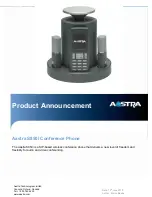
have a label on the box. These ratings are not guaranteed. Results will vary, depending on the level of immunity
of your hearing device and the degree of your hearing loss. If your hearing device happens to be vulnerable to
interference, you may not be able to use a rated phone successfully. Trying out the phone with your hearing
device is the best way to evaluate it for your personal needs.
This phone has been tested and rated for use with hearing aids for some of the wireless technologies that it
uses. However, there may be some newer wireless technologies used in this phone that have not been tested
yet for use with hearing aids. It is important to try the different features of this phone thoroughly and in different
locations, using your hearing aid or cochlear implant, to determine if you hear any interfering noise. Consult
your service provider or the manufacturer of this phone for information on hearing aid compatibility. If you have
questions about return or exchange policies, consult your service provider or phone retailer.
M-Ratings: Phones rated M3 or M4 meet FCC requirements and are likely to generate less interference with
hearing devices than phones that are not labeled. M4 is the better/higher of the two ratings.
T-Ratings: Phones rated T3 or T4 meet FCC requirements and are likely to be more usable with a hearing device’s
telecoil (“T Switch” or “Telephone Switch”) than unrated phones. T4 is the better/higher of the two ratings. (Note
that not all hearing devices contain telecoils.)
Your Z353VL has been tested for hearing aid device compatibility and has an M4/T4 rating.
Hearing devices may also be measured for immunity to this type of interference. Your hearing device
manufacturer or hearing health professional may help you find results for your hearing device.
For additional information about the FCC’s actions with regard to hearing aid compatible wireless devices and
other steps the FCC has taken to ensure that individuals with disabilities have access to telecommunications
services, please go to www.fcc.gov/cgb/dro.
Distraction
Driving
Full attention must be given to driving at all times in order to reduce the risk of an accident. Using a phone while
driving (even with a hands free kit) can cause distraction and lead to an accident. You must comply with local
laws and regulations restricting the use of wireless devices while driving.
Operating Machinery
Full attention must be given to operating machinery in order to reduce the risk of an accident.
Product Handling
General Statement on Handling and Use
You alone are responsible for how you use your phone and any consequences of its use.
You must always turn off your phone wherever the use of a phone is prohibited. Use of your phone is subject to
safety measures designed to protect users and their environment.
• Always treat your phone and its accessories with care and keep it in a clean and dust-free place.
• Keep the screen and camera lens clean. Unclean screen or camera lens may slow down the phone’s reaction
to your operations or lower image quality.
• Clean the device and its accessories with a soft material such as cleaning cloth for eyeglass lenses. Do not
use alcohol or other corrosive substances for cleaning or allow them to get inside.
• Do not expose your phone or its accessories to open flames or lit tobacco products.
• Do not expose your phone or its accessories to liquid, moisture or high humidity.
• Do not drop, throw or try to bend your phone or its accessories.
• Do not use harsh chemicals, cleaning solvents, or aerosols to clean the device or its accessories.
• Do not paint your phone or its accessories.
• Do not attempt to disassemble your phone or its accessories. Only authorized personnel can do so.
• Do not expose or use your phone or its accessories in an environment with or that can reach extreme
temperatures, minimum - [5] and m [50] degrees Celsius.
• Do not place your phone inside or near heating equipment or high-pressure containers, such as water
heaters, microwave ovens, or hot cooking utensils. Otherwise, your phone may be damaged.
• Please check local regulations for disposal of electronic products.
• Do not carry your phone in your back pocket as it could break when you sit down.
Small Children
Do not leave your phone and its accessories within the reach of small children or allow them to play with it. They
could hurt themselves or others, or could accidentally damage the phone. Your phone contains small parts with
sharp edges that may cause an injury or may become detached and create a choking hazard.
Demagnetization
To avoid the risk of demagnetization, do not allow electronic devices or magnetic media to be close to your
phone for a long time.
Electrostatic Discharge (ESD)
Do not touch the micro-SIM/SD card’s metal connectors.
Antenna
Do not touch the antenna unnecessarily.
Normal Use Position
When placing or receiving a phone call, hold your phone to your ear, with the bottom towards your mouth.
Air Bags
Do not place a phone in the area over an air bag or in the air bag deployment area as an airbag inflates with great
force and serious injury could result. Store the phone safely before driving your vehicle.
Seizures/Blackouts
The phone can produce a bright or flashing light. A small percentage of people may be susceptible to blackouts
or seizures (even if they have never had one before) when exposed to flashing lights or light patterns such as
when playing games or watching video. If you have experienced seizures or blackouts or have a family history
of such occurrences, please consult a physician. To reduce the risk of blackouts or seizures, you can use your
phone in a well-lit room and take frequent breaks.
Repetitive Strain Injuries
To minimize the risk of Repetitive Strain Injury (RSI) when texting or playing games with your phone:
• Do not grip the phone too tightly.
• Press the buttons lightly.
• Use the special features that are designed to minimize the times of pressing buttons, such as Message
Templates and Predictive Text.
• Take many breaks to stretch and relax.
Emergency Calls
This phone, like any wireless phone, operates using radio signals, which cannot guarantee connection in all
conditions. Therefore, you must never rely solely on any wireless phone for emergency communications.



































